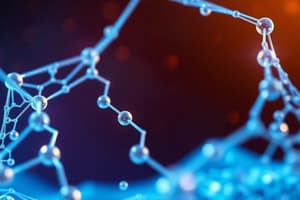Podcast
Questions and Answers
What advantage do graphene oxide filters have in the process of desalination?
What advantage do graphene oxide filters have in the process of desalination?
- They can outperform other desalination techniques due to size control. (correct)
- They can reduce energy consumption significantly.
- They can increase the salinity of water.
- They are more expensive to produce than other filters.
How do graphene oxide membranes function in ethanol distillation?
How do graphene oxide membranes function in ethanol distillation?
- They permit water vapor to pass while blocking other liquids and gases. (correct)
- They are impermeable to all substances.
- They can selectively pass ethanol only.
- They allow both liquids and gases to pass through.
What is a potential benefit of utilizing graphene in supercapacitors?
What is a potential benefit of utilizing graphene in supercapacitors?
- Improved stability of the supercapacitor components.
- Greater energy storage density than currently available. (correct)
- Longer charging times for energy storage.
- Lower energy storage density compared to current options.
What role do graphene oxide sheets play in addressing bacterial contamination?
What role do graphene oxide sheets play in addressing bacterial contamination?
Which of the following applications is NOT mentioned as a potential use for graphene?
Which of the following applications is NOT mentioned as a potential use for graphene?
What is the structural arrangement of carbon atoms in graphene?
What is the structural arrangement of carbon atoms in graphene?
Which of the following materials is graphene compared to in terms of hardness?
Which of the following materials is graphene compared to in terms of hardness?
What is the maximum stretch capability of graphene relative to its initial length?
What is the maximum stretch capability of graphene relative to its initial length?
Which technique was used to measure the strength of graphene?
Which technique was used to measure the strength of graphene?
Who were the key researchers that extracted graphene in 2004?
Who were the key researchers that extracted graphene in 2004?
Which property of graphene relates to its reactivity?
Which property of graphene relates to its reactivity?
What is a unique feature of graphene's 2D structure regarding chemical reactions?
What is a unique feature of graphene's 2D structure regarding chemical reactions?
What type of material does graphene classify as, based on its electronic properties?
What type of material does graphene classify as, based on its electronic properties?
What is a notable characteristic of electron flow in graphene compared to copper?
What is a notable characteristic of electron flow in graphene compared to copper?
Which of the following statements about graphene's thermal conductivity is accurate?
Which of the following statements about graphene's thermal conductivity is accurate?
Why is graphene considered suitable for use in transparent conducting electrodes?
Why is graphene considered suitable for use in transparent conducting electrodes?
What application is proposed for graphene in the field of biotechnology?
What application is proposed for graphene in the field of biotechnology?
How does graphene compare to graphite in terms of thermal conductivity?
How does graphene compare to graphite in terms of thermal conductivity?
What are the potential benefits of using graphene in integrated circuits?
What are the potential benefits of using graphene in integrated circuits?
What factor contributes to graphene's ability to be visible to the naked eye despite being only one atom thick?
What factor contributes to graphene's ability to be visible to the naked eye despite being only one atom thick?
What is a significant implication of graphene's high electron mobility and thermal conductivity for chip technology?
What is a significant implication of graphene's high electron mobility and thermal conductivity for chip technology?
Flashcards are hidden until you start studying
Study Notes
Introduction
- Graphene is a single-atom thick layer of graphite.
- It is the basic building block of other carbon structures, including graphite, charcoal, carbon nanotubes, and fullerenes.
- It is the strongest and thinnest material known.
Structure
- Graphene is a 2D crystal of carbon atoms arranged in a honeycomb lattice.
- Each carbon atom is sp² hybridized and bonded to its three nearest neighbors.
Dimensionality
- 0D materials include nanospheres, clusters, quantum dots, fullerenes, and gold.
- 1D materials include nanotubes, wires, rods, metal nanorods, carbon nanotubes, and metallic nanotubes.
- 2D materials include thin films, plates, layered structures, carbon coated nanoplates, and graphene sheets.
- 3D materials include bulk nanomaterials, polycrystals, liposomes, and polycrystalline materials.
History
- The first patent for graphene production was filed in 2002.
- In 2004, Andre Geim and Kostya Novoselov extracted single-atom-thick graphene sheets from graphite.
- Geim and Novoselov received the 2010 Nobel Prize in Physics for their groundbreaking research.
Mechanical Properties
- Graphene's strength was measured using Atomic Force Microscopy.
- Graphene is harder than diamond and 300 times harder than steel.
- Its tensile strength exceeds 1 TPa.
- It is stretchable up to 20% of its original length.
Chemical Properties
- Graphene is the most chemically reactive form of carbon.
- Each carbon atom is exposed for chemical reactions from both sides due to its 2D structure.
- Carbon atoms at the edges of graphene sheets are particularly reactive.
- Graphene burns at a low temperature (350°C).
- It has the highest ratio of edge carbons compared to similar materials like carbon nanotubes.
- Graphene is commonly modified with oxygen and nitrogen-containing functional groups.
Electronic Properties
- Graphene is a zero-overlap semimetal, with both holes and electrons as charge carriers.
- It has very high electrical conductivity, even exceeding copper.
- Electrons travel through graphene with almost no mass, reaching speeds of almost one hundredth the speed of light.
- High charge carrier mobility values of 10,000 cm²/Vs, and even up to 200,000 cm²/Vs, have been reported.
Thermal Properties
- Graphene is a perfect thermal conductor.
- Its thermal conductivity is higher than other carbon structures like carbon nanotubes, graphite, and diamond (> 5000 W/m/K) at room temperature.
- Graphite, the 3D version of graphene, has a thermal conductivity about 5 times lower (1000 W/m/K).
- Graphene's thermal conductance is isotropic, meaning it is the same in all directions.
- Its high electron mobility and thermal conductivity could lead to faster and more efficient heat dissipation in chips.
Optical Properties
- Graphene, despite its single-atom thickness, is visible to the naked eye.
- Due to its unique electronic properties, it absorbs 2.3% of the light passing through it.
Applications
- Graphene has potential in a wide range of applications, including electronics, bioengineering, filtration, lightweight/strong composite materials, photovoltaics and energy storage.
Biomedical
- Graphene could be used for high-speed DNA analysis.
Integrated Circuits
- Graphene's high carrier mobility and low noise make it suitable for use in field-effect transistors.
- Processors with 100 GHz transistors on 2-inch graphene sheets are being explored.
- Graphene-based integrated circuits have reached frequencies up to 10 GHz.
- Transistors printed on flexible plastic operate at 25 GHz.
- Terahertz-speed transistors are a possibility.
Optical Electronics
- Graphene's high electrical conductivity and optical transparency make it a candidate for transparent conducting electrodes.
- Its mechanical strength and flexibility offer advantages over brittle indium-tin oxide.
- Promising for optoelectronic applications: touchscreens, LCD displays, organic photovoltaic cells, and OLEDs.
Filters
- Desalination: Graphene oxide filters could outperform other desalination techniques due to precise control of pore size.
- Ethanol distillation: Graphene oxide membranes allow water vapor to pass through but are impermeable to other liquids and gases. This could revolutionize biofuel production and the alcoholic beverage industry.
Solar Cells
- Graphene is promising in dye-sensitized solar cells for photoelectrochemical energy conversion.
- Transparent, conductive, and ultrathin graphene films are fabricated from exfoliated graphite oxide.
- These films show high conductivity (550 S/cm) and transparency (> 70%) over 1000-3000 nm.
Energy Storage Devices
- Graphene's high surface area to mass ratio makes it suitable for conductive plates in supercapacitors.
- It could lead to supercapacitors with greater energy storage density.
Anti-Bacterial
- Graphene oxide is highly effective at killing bacteria like E. coli.
- It has potential in hygiene products and packaging for food preservation.
Other Applications
- Graphene nanoribbons
- IR detectors
- Single-molecule gas detection
- Piezoelectric materials
- Energy Harvesting
- Composite Materials
- Liquid Cells for Electron Microscopy
- Thermal management materials
- Optical Modulators
- Chemical sensors
Conclusion
- Graphene is a remarkable material with the potential to revolutionize various fields.
- Its diverse applications span from electronics and energy storage to biomedical devices.
Studying That Suits You
Use AI to generate personalized quizzes and flashcards to suit your learning preferences.




